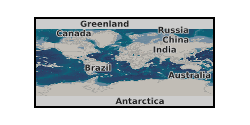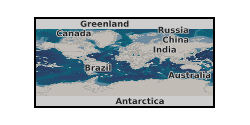2012
Type of resources
Available actions
Topics
Keywords
Contact for the resource
Provided by
Years
Formats
Representation types
Update frequencies
Service types
Scale
Resolution
-

This dataset contains data from a marine geophysical and multibeam survey which took place in April 2012 in the area of Ardmucknish Bay on board the RV White Ribbon. This was a follow up survey to the previous work carried out in this area in 2011 (2011/4). QICS (Quantifying and monitoring potential ecosystem impacts of geological carbon storage) was a scientific research project funded by NERC; its purpose was to improve the understanding of the sensitivities of the UK marine environment to a potential leak from a carbon capture storage (CCS) system. The aim of the survey was to assess any affect the drilling of the borehole had on the underlying sediments. Sea floor bathymetry data were collected using a Kongsberg EM3002D multibeam system. Sub bottom seismic profiling data were collected using an Applied Acoustics surface tow boomer (STB). Technical details of the survey are contained in the BGS Report of Survey. Webpage www.bgs.ac.uk/QICS/. NERC Grant NE/H013954/1.
-

Pre-proposal cover sheet for scientific drilling 'GlaciStore: Understanding Late Cenozoic glaciation and basin processes for the development of secure large-scale offshore CO2 storage (North Sea)', submitted to Integrated Ocean Discovery Programme (IODP) March 2014. The pre-proposal cover sheet document is publicly available from IODP; the submitted pre-proposal document is restricted to the proponents for publication and to progress to full proposal to IODP. The lead submitter, on behalf to the GlaciStore consortium is Heather Stewart, British Geological Survey (BGS).The 25 proponents are from research and industry organisations in the UK and Norway (BGS, Institute for Energy Technology, Lundin Norway AS, SINTEF Energy Research, Statoil ASA, University of Bergen, University of Edinburgh and University of Oslo). The pre-proposal cover sheet states the names of proponents of the 'GlaciStore' consortium and contact details for the lead submitter of the bid. The pre-proposal cover sheet comprises an abstract of the submitted pre-proposal, describes and states the scientific research objectives, and tabulates details of the 12 proposed drill sites to address the scientific objectives. The objectives are to investigate the glacial history and sedimentary architecture, fluid flow and processes, and the stress history and geomechanical response in strata that have experienced multiple glacial and interglacial cycles. The table of proposed drilling sites includes the co-ordinates of the position and water depth at each proposed site, the objective for drilling and sampling and the depth to achieve the objective. The IODP pre-proposal cover sheet is a pdf format file. UKCCSRC Grant UKCCSRC-C1-30
-

Full proposal cover sheet for scientific drilling (852-CPP) 'GlaciStore: Understanding Late Cenozoic glaciation and basin processes for the development of secure large-scale offshore CO2 storage (North Sea)', submitted to Integrated Ocean Discovery Programme (IODP) April 2014. The full proposal cover sheet document is publicly available from IODP; the submitted full proposal document is restricted to the proponents for publication and for review and response from IODP. The lead submitter, on behalf to the GlaciStore consortium is Heather Stewart, British Geological Survey (BGS).The 30 proponents are from research and industry organisations in the UK, Norway and USA (BGS, Institute for Energy Technology, Lundin Norway AS, SINTEF Energy Research, Statoil ASA, University of Bergen, University of Edinburgh, University of Oslo and University of Texas at Austin). The full proposal cover sheet states the names of proponents of the ‘GlaciStore’ consortium and contact details for the lead submitter of the bid. The full proposal cover sheet comprises: an abstract of the submitted full proposal including description of project funding support as a Complementary Project Proposal: describes and states the scientific research objectives; summarises proposed non-standard measurements; tabulates details of the 13 proposed drill sites (revised from pre-proposal stage) to address the scientific objectives. The objectives are to investigate: glacial history and sedimentary architecture; fluid flow and microbial processes in shallow sediments; and the stress history and geomechanical models for strata that have experienced multiple glacial and interglacial cycles. The table of proposed drilling sites includes the co-ordinates of the position and water depth at each proposed site, the objective for drilling and sampling and the depth to achieve the objective. The proponents, their affiliation, expertise and role for the submission are listed. UKCCSRC Grant UKCCSRC-C1-30.
-
The Airborne Research & Survey Facility (ARSF, formerly Airborne Remote Sensing Facility) is managed by NERC Scientific Services and Programme Management. It provides the UK environmental science community, and other potential users, with the means to obtain remotely-sensed data in support of research, survey and monitoring programmes. The ARSF is a unique service providing environmental researchers, engineers and surveyors with synoptic analogue and digital imagery of high spatial and spectral resolution.The NEODC holds the entire archive of Airborne Thematic Mapper (ATM) and Compact Airborne Spectrographic Imager (CASI) data acquired by the NERC ARSF. High-resolution scanned digital versions of the entire collection of analogue photographs are now also available as well as selected LiDAR-derived elevation and terrain models for selected sites flown using the sensor.
-
This dataset has been produced as part of the Theme 5 (Cryosphere and Polar Oceans) in the National Centre for Earth Observation which aims to use new EO data to quantify changes in the mass balance of the cryosphere and to develop new models to represent the relevant processes in coupled climate prediction models. This dataset holds timeseries of Greenland glacier velocity fluctuations as maps for the period March-July 2011. The 37 velocity maps were derived from SAR data acquired during the 2011 ERS-2 3-day campaign. The velocity maps are 3-day velocity averages and are given in meters per year (m/y) (magnitude values). The name of the velocity files provides the start and end date of each 3-day period. The velocity fields were transformed to map coordinates using the GLAS/ICESat 1 km Laser Altimetry Digital Elevation Model of Greenland which is provided at Polar Stereographic grids (DiMarzio, J., Brenner, A., Schutz, R., Schuman, A. & Zwally, H.J. (2007)): GLAS/ICESat 1 km laser altimetri digital elevation model of Greenland. Boulder, Colorado USA: National Snow and Ice Data Centre. Digital media).
-
The Airborne Research & Survey Facility (ARSF, formerly Airborne Remote Sensing Facility) is managed by NERC Scientific Services and Programme Management. It provides the UK environmental science community, and other potential users, with the means to obtain remotely-sensed data in support of research, survey and monitoring programmes. The ARSF is a unique service providing environmental researchers, engineers and surveyors with synoptic analogue and digital imagery of high spatial and spectral resolution.The NEODC holds the entire archive of Airborne Thematic Mapper (ATM) and Compact Airborne Spectrographic Imager (CASI) data acquired by the NERC ARSF. High-resolution scanned digital versions of the entire collection of analogue photographs are now also available as well as selected LiDAR-derived elevation and terrain models for selected sites flown using the sensor.
-
The Airborne Research & Survey Facility (ARSF, formerly Airborne Remote Sensing Facility) is managed by NERC Scientific Services and Programme Management. It provides the UK environmental science community, and other potential users, with the means to obtain remotely-sensed data in support of research, survey and monitoring programmes. The ARSF is a unique service providing environmental researchers, engineers and surveyors with synoptic analogue and digital imagery of high spatial and spectral resolution.The NEODC holds the entire archive of Airborne Thematic Mapper (ATM) and Compact Airborne Spectrographic Imager (CASI) data acquired by the NERC ARSF. High-resolution scanned digital versions of the entire collection of analogue photographs are now also available as well as selected LiDAR-derived elevation and terrain models for selected sites flown using the sensor.
-
The Airborne Research & Survey Facility (ARSF, formerly Airborne Remote Sensing Facility) is managed by NERC Scientific Services and Programme Management. It provides the UK environmental science community, and other potential users, with the means to obtain remotely-sensed data in support of research, survey and monitoring programmes. The ARSF is a unique service providing environmental researchers, engineers and surveyors with synoptic analogue and digital imagery of high spatial and spectral resolution.The NEODC holds the entire archive of Airborne Thematic Mapper (ATM) and Compact Airborne Spectrographic Imager (CASI) data acquired by the NERC ARSF. High-resolution scanned digital versions of the entire collection of analogue photographs are now also available as well as selected LiDAR-derived elevation and terrain models for selected sites flown using the sensor.
-
The 20th Century Reanalysis dataset provides 6 hourly analyses on a global grid from 1870 to present produced from a series of 56-member ensemble runs. These data are the from each of the 56 ensemble members from the run covering 1935 to 1940. These data were produced on a 2 degree latitude-longitude (180x91) global grid and include data both at the surface and on pressure levels. The dataset authors request that the following acknowledgment be included in all papers using the dataset: 'Support for the Twentieth Century Reanalysis Project dataset is provided by the U.S. Department of Energy, Office of Science Innovative and Novel Computational Impact on Theory and Experiment (DOE INCITE - http://www.doeleadershipcomputing.org/incite-program/ ) program, and Office of Biological and Environmental Research (BER - http://science.energy.gov/ber/ ), and by the National Oceanic and Atmospheric Administration Climate Program Office (http://www.climate.noaa.gov/).'
-
Airborne atmospheric measurements from core instrument suite data on board the FAAM BAE-146 aircraft collected for AETIAQ - Aviation Emissions and Their Impact on Air Quality project.
 NERC Data Catalogue Service
NERC Data Catalogue Service